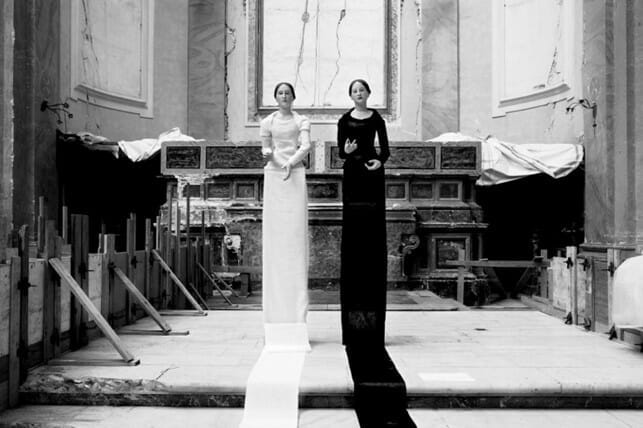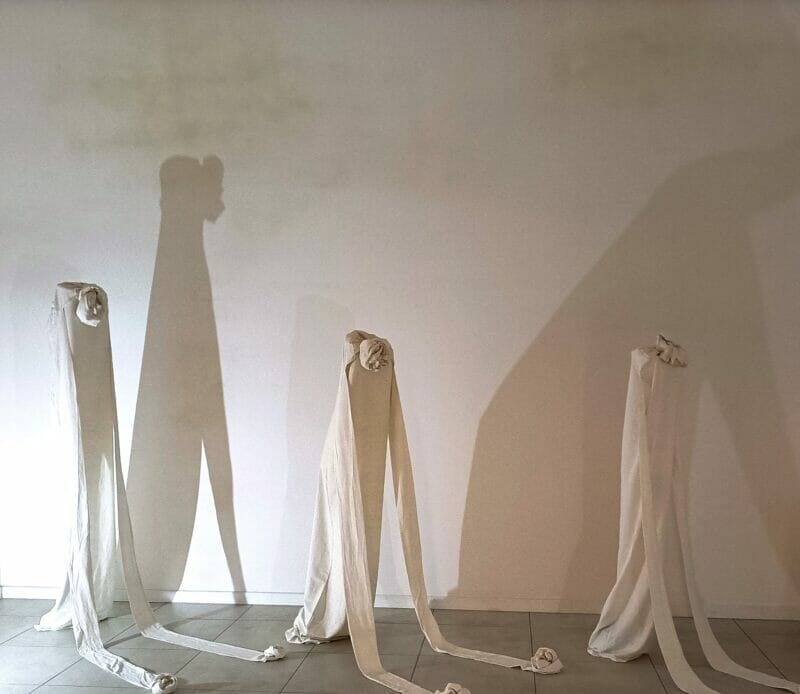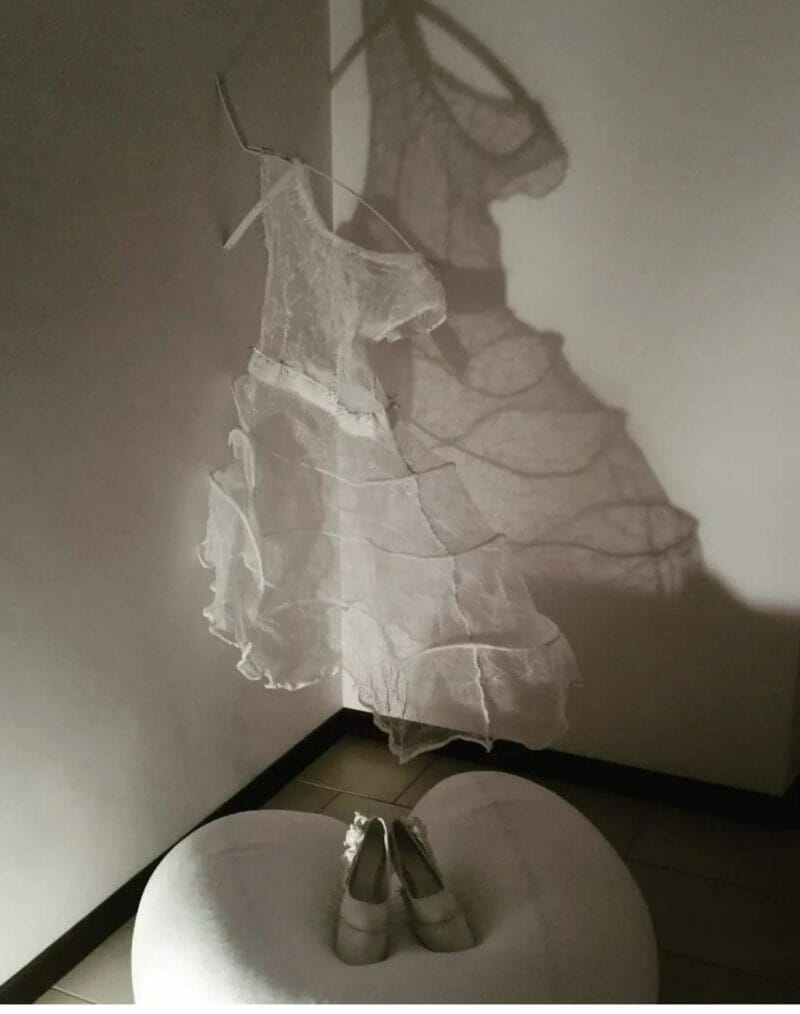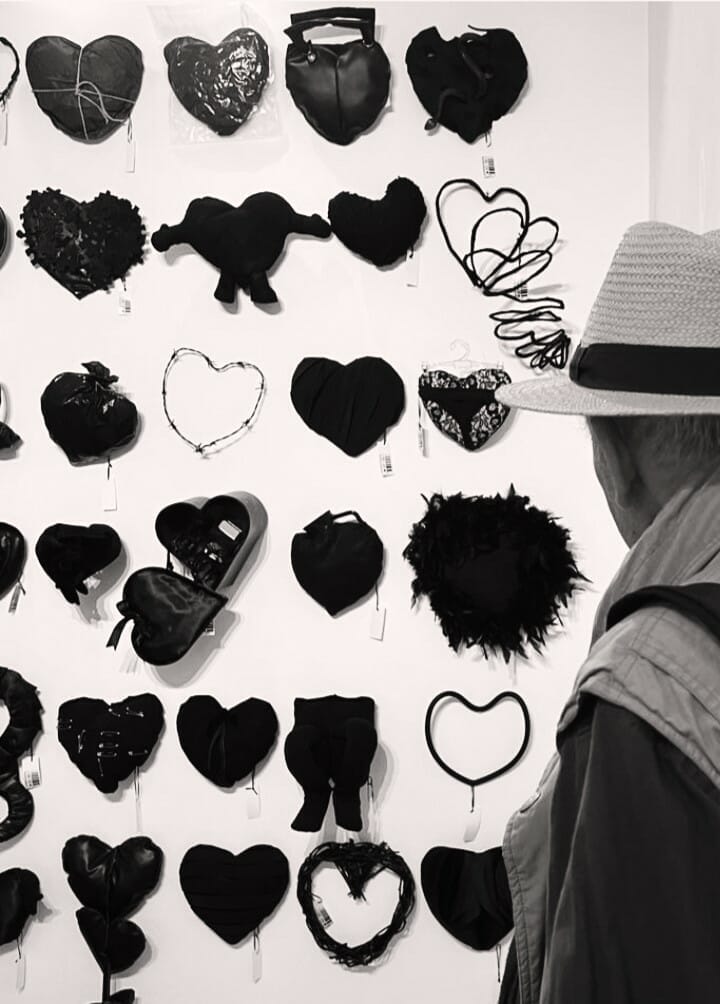DONATELLA GIAGNACOVO
*Feature photo: Una ogni 11 minuti. Inspiration Museum Janina Monkute-Marks Lithuania 2023
Donatella Giagnacovo, a polymathic visual artist, graduated from the Academy of Fine Arts in L’Aquila, Italy, as well as specializations and licenses for teaching art subjects. She has participated in numerous solo and group exhibitions including: Luco (Galleria Italia, L’Aquila), Il peso del vuoto (SCD Textile Art Studio, Perugia)
How did your connection with contemporary art come about and when did you realize you would pursue this artistic path?
I was introduced to the world of art while attending high school. I had the great opportunity to meet an enlightened Drawing and Art History teacher. He dilated horizons, subverted our adolescent certainties. He succeeded in filtering the events and fears of an ideologically vibrant topicality through the historical and critical reading of artistic evidence that was only chronologically distant. He pushed us to analysis, to insights, not to glide over situations but to penetrate them deeply. I still remember his timbre of voice, his pauses that gave time to our reasoning, his hands on my drawing paper. All this led me to make a choice, not of profession but of interest and passion. I enrolled in the Academy of Fine Arts and knowing nothing about specific techniques and languages, I also attended the State Art Institute as a private student. Attending workshops, organizing work in support of creative thinking, acquiring instrumental and dialectical visual vocabulary were constant elements of an extended practice that embraced research, experimentation, the absolute necessity of trying and engaging in a dialogue of exchange and willingness toward an unusual, often opaque and disorienting expressive linguistics, perhaps for this reason stimulating. I have never chosen rationally but have always tried to listen to myself without stifling the most inner needs. I have been in the profession of teaching art subjects for very many years, this has allowed me to constantly reinforce and deepen structural knowledge to my research work. Moreover, dialectical communication, daily present not only in the transfer of functional learnings to an artistic knowledge, but especially directed to the acquisition of a critical awareness towards the expressive potential of all Art, has certainly contributed to my vision of art making. I do not believe in easy generalizations of categories, I believe that each individual’s mode of being is the result of specific experiences, training, encounters, subjective peculiarities. I would not have been able or desired to do anything else.
You are a textile artist who prefers works with an installation character. How do you choose the materials you relate to and the object you give form to?
I am also a textile artist, often working with other materials. I go through them relying on their peculiarities to express what is desired. They are not parts of something, they are themselves concept and message. It follows that the space sought can be two-dimensional or three-dimensional or installation. There is no a priori choice. The work arises from the material that is already expression, in its very specificity: surface or volume that reinforces or negates in space, what I convey. Textiles and fibers in general, as well as papers but also recycled plastics, convey to me their intrinsic mode, which I welcome by making it an expressive vehicle or metaphor. The materials have a form, a history, a concreteness that I try to sustain even if only as an emotional testimony, an attempt perhaps to assign, if only temporarily, a disorienting pause from the speed of undoing to acquire that seems to be now daily practice.
Within your artistic research we find the discourse of gender-based violence. In your opinion as an artist and as a woman, can art be useful in raising awareness of this issue?
Instinctively I would be inclined to answer “as long as it is talked about…” But that would obviously be a hasty answer. Hasty solutions are slogans that leave time for themselves. The problem is perhaps something else. How much contemporary art is an expression of its time. And if in part it is, how much is it listened to? The obvious short circuit is between an economic art system blatantly disconnected with a professed art system. In between is a society that is distracted, disoriented, or simply interested in something else. The communicative potential of art is not questioned but I think more than one reflection should arise on how much the communication of art, in our country, is supported and facilitated. Attending a museum institution, attending an event, visiting an exhibition in many territories is still a utopia and it is for many categories of people. Personally, I believe that events for insiders, messaging on social media for followers of the field… are expressions of an apparent and satisfying dialogue only because today’s virtual age has diluted the boundaries, but the areas are still sectorial. It follows that those who practice art live in a closed communicative system and talk over themselves. The society poured on itself is a society that does not listen and is not listened to, and although there are in various museum and non-museum realities, opportunities to experience art as a confrontation and space of knowledge and sharing open to the inescapable categories of a factual social system: families, young people, children… and although there are in many territories outposts of confrontation stimulated by relational art practices, everything is always the result of a few visionary minds and a lot of volunteer work. I believe in the educational and formative value of visual art, and I am convinced that many of the artists today are bearers of high, forward-looking and visionary paths. But it would be desirable to have an economic art system that invests, with greater capillarity on visual art as a method that is also educational and participatory. In the meantime, it is absolutely necessary that art that addresses and confronts “social” issues such as gender violence be given the opportunity to find ample space for concrete dialogue for a communicative process of meaning, within a cultural path aimed at not leaving social voids in the shadows.

In your work the use of color appears to be nil or minimal; the works are often monochrome and feature black and white as protagonists. What meaning do you give to these two hues?
Beyond the purely physical explanation regarding the negation and/or sum of all colors, the two types of non-color generating maximum brightness or conversely deep darkness, in being so seemingly definitive and stated are deceptive. The same metaphor is perfectly reconciled by overlaying my works that deliberately play on delicate and impalpable textures or, conversely, on sharp and predominant forms that force you to read deeper. The tranquilizing and soporific white, the murky and disturbing black are two pinnacles of a visual method only seemingly anesthetizing but on the contrary forcing you to open your eyes, to extend your gaze. Not secondary is the use of commonly assimilated reference symbolism. In ” Dolor et Spes,” (Installation-action shared with Fabrizio Colagrande, Paolo Di Pietro, Sergio Maritato, photographers and Daniela Colagrande and Luca Cococcetta Video-makers and curatorial feedback from Gianluigi Simone, Umberto Palestini, Sabrina Vedovotto, Teramo- Rome 2010), installation for post-earthquake L’ Aquila, two wooden conocchie, half-bust madonnas, with their robes extended across the floor of the nave of the still unrebuilt Basilica of San Bernardino, were relocated to reaffirm a collective urgency. The need to experience communal mourning to the core and the need, beyond the clamor, to find hope at the end of the tunnel. Black and White, Black and White, the whole and then the nothing from which to start again.
In “Il Peso del Vuoto” (The Weight of Emptiness) from the cycle “Di Bianche Spine” (Of White Thorns), curated by Barbara Pavan, SCD Textile & Art studio, Perugia 2023, the viewer is greeted by forms, wrappings and objects of an everyday feminine life that if seemingly delicate, graceful and reassuring, show in rawness the falsehood and deception that feed on still widespread stereotypes that inevitably weigh on women’s lives.
In the series “Una ogni 11 minuti” (an installation already selected for the Syart Festival Sorrento of Contemporary Art 2022 and currently on display at the Janina Monkute-Marks Museum, Kèdainiai – Lithuania on the occasion of the international event “Inspiration”) White testifies, through a visual narrative that investigates some types of certified abuse of which women are still victims today, to the urgency of shedding light on the darkness of evil.
In the event LUCO (international diffuse exhibition of Contemporary Art investigating the meaning of the sacred in current events, curated by Barbara Pavan. L’Aquila 2023) the installation “Muta preghiera” conveys, through the whiteness of three ascetic elements, the need for a total purification in order to reconnect with the innermost part of ourselves a premise for a healing meditation.
The evanescence of the materials leads to a reflection beyond the visible, just as in the group show Trasparenze, sguardi oltre (curated by Margaret Sgarra September-October 2023, La via Lattea Turin) the aim is to overcome the veil that superficially covers muffled realities to which to reassign a proper visual saturation through an unfiltered exhibition.
Speaking of hues, Cuore Nero (Black Heart) is the title of the solo exhibition curated by Barbara Pavan that opened on September 30 at La Dama in Capestrano. Can you tell us about the focus of this project?
Cuore Nero (Black Heart) is a 2008 work that all these years later remains sadly and limpidly relevant. A Black Heart is in each of the thirty elements that make up this installation; it maintains its modular rhythm, its visual balance, but is endowed with subjectivity. The path is a registry of the betrayals of our expectations is, as curator Barbara Pavan writes, an archive of bad herbs, is to lay bare the dark part of ourselves until we sink into it. The total blackness as well as the iconic form, are levels of immediate and epidermal perception, but to detect their diversity it is necessary to pause, and in this pause it is not difficult to find a part of us that we deliberately keep hidden. In scrolling through the visual structures in sequence, we sense the paradox of an affirmed negation supported by a rampant ambiguity. The short circuit, only seemingly semantic, can perhaps be interrupted by the presence of another bread heart. Disruptive in its essentiality.




